Coronavirus Higher Education Industry Briefing: May 19

Community College Remains Top of Mind
Today’s Briefing analyzes publicly available online conversation in the U.S. and on Reddit and YouTube (which span beyond the U.S.) about the coronavirus and higher education from May 11–17. In this analysis of volume, topics, sentiment, and key audiences, we highlight conversation about community colleges (again!) and summarize trends from our ten weeks of Briefings.
Today is our final Briefing. You can view all 15 Briefings from Mach, April, and May at info.campussonar.com/covid19. Because of the changing nature of social media data and our understanding of the conversation, each Briefing covers a distinct point in time. Comparisons from Briefing to Briefing may be helpful, but we can’t draw correlations like we could if we were using other datasets such as surveys or historical social media data.
Conversation Volume Decreased Slightly
We identified over 362,000 conversations about the coronavirus and higher education May 11–17, ranging from 34,000 to 70,000 per day—about 11 percent fewer mentions than last week. Sixteen percent of mentions referred to the fall semester or beyond.
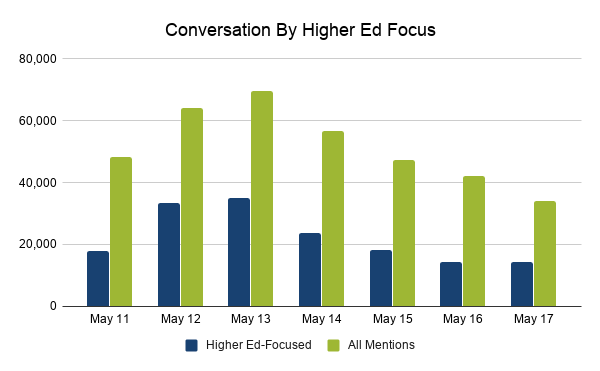 Forty-three percent of all mentions were higher ed-focused, consistent with last week. Of those mentions, 20 percent referenced the fall semester or later. Remember, our industry-level analysis only captures general higher education mentions. If someone mentions the name or acronym of an institution without using a higher ed term (e.g., campus, university, college, classes, etc.), it’s not included in this analysis. Actual volume of conversation across the industry is likely much higher.
Forty-three percent of all mentions were higher ed-focused, consistent with last week. Of those mentions, 20 percent referenced the fall semester or later. Remember, our industry-level analysis only captures general higher education mentions. If someone mentions the name or acronym of an institution without using a higher ed term (e.g., campus, university, college, classes, etc.), it’s not included in this analysis. Actual volume of conversation across the industry is likely much higher.
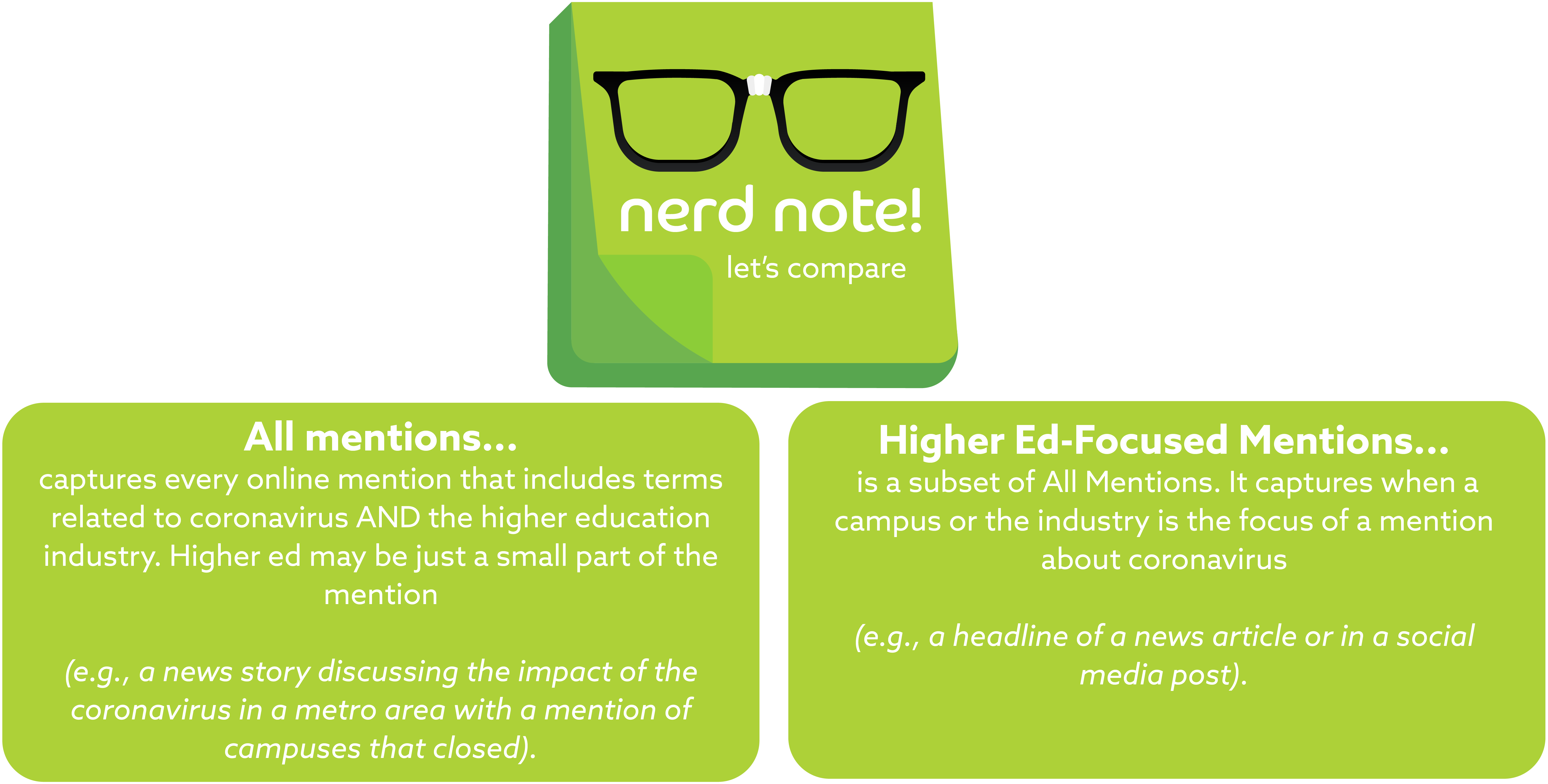
Content Source Patterns Continue
At the risk of sounding like a broken record, the places we find conversation about the coronavirus and higher education are largely the same as last week. Social media is the most common source for all mentions and higher ed-focused mentions, while conversation from students is more likely to occur on forums (particularly Reddit).
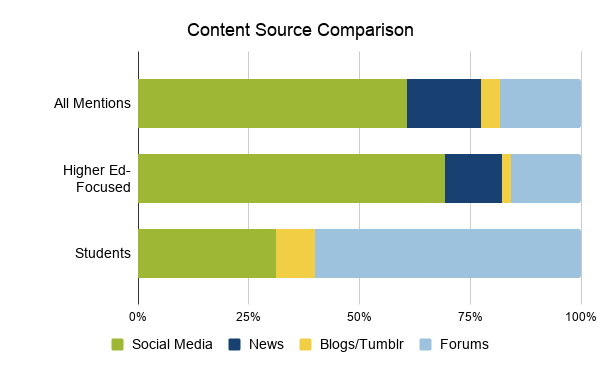 Remember that due to data access restrictions, we aren’t including Facebook, Instagram, Snapchat, TikTok, or LinkedIn in our analysis. Your campus social media manager is the best source of information regarding conversation on those networks. Depending on the software used, social listening for a specific campus can include Facebook and Instagram mentions once account managers verify admin access.
Remember that due to data access restrictions, we aren’t including Facebook, Instagram, Snapchat, TikTok, or LinkedIn in our analysis. Your campus social media manager is the best source of information regarding conversation on those networks. Depending on the software used, social listening for a specific campus can include Facebook and Instagram mentions once account managers verify admin access.
“In-Person Classes” Emerged As Trending Topic
The following word cloud includes the top 100 people, phrases, and emojis in higher ed-focused conversation May 11–17. Other than the phrases we’ve seen every week related to the pandemic and online classes, this week we continued to see conversation about community colleges, the California State University (CSU) announcement, in-person classes, “black,” and college football.
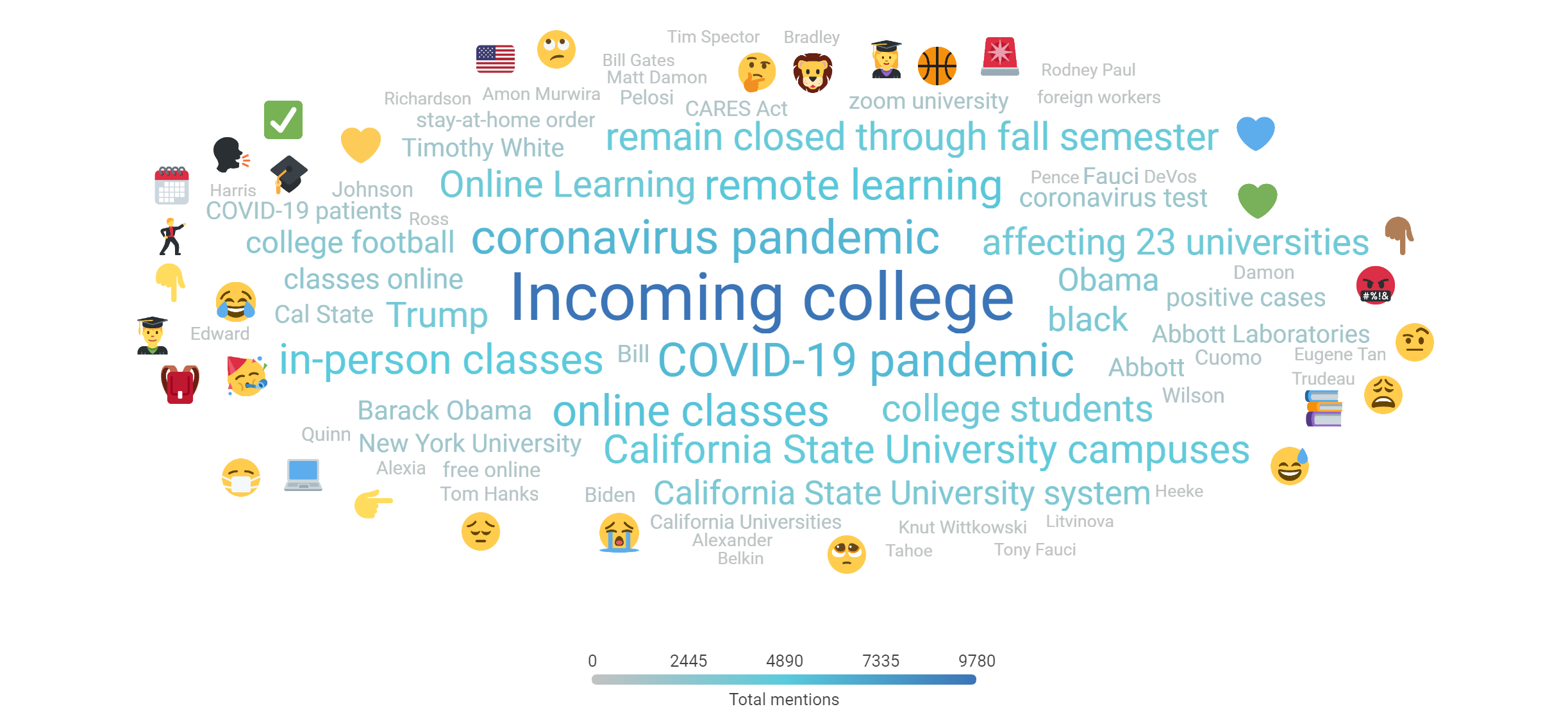
For the last two weeks, “community college” has been a top topic. While at first glance it may appear to be missing from this topic cloud, it’s right in the middle. “Incoming college,” the most popular phrase from May 11–17, comes from another viral tweet shared by a person with average social media influence suggesting community college as the preferred option this fall. Offered as a quote retweet commenting on the news of CSU’s fall announcement, it received over 100,000 engagements. In subsequent tweets, the author explains he reluctantly attended a junior college and now realizes it was a good choice. The 90 replies to this tweet offer yet another interesting online focus group opportunity as people share their thoughts and opinions about community college. A less viral, but still popular tweet with over 7,000 engagements also urged students to take their first year at community college. The more popular of these two tweets referred to “CC.” If the author had used the phrase “community college,” it would have been one of our most popular higher ed-focused topics for the third week in a row.
“In-person classes” was the sixth most popular topic, right behind “online classes” and “remote learning.” There wasn’t any particular mention that drove this phrase to the top; discussion of in-person classes happened in social media, forums, and in the news. This is the first time this topic appeared in our top topics list, and I believe that’s notable. “Online classes” is no longer the only instructional modality that requires a modifier. This may be a glimpse into our future, as the public (including students) and institutions have to specify the delivery method when discussing classes.
Four of the top 20 topics related to CSU’s announcement that fall semester courses would be mainly online. The May 12 announcement contributed to the peak in higher ed-focused conversation that day as well as the following day.
“Black” remains in the top 20 topics. We analyzed this topic in detail in prior Briefings (May 5 and April 21). One driver of this topic May 11–17 was the national Historically Black Colleges and Universities (HBCU) commencement celebration and national celebration for high school graduates, both of which included an address by former President Obama. The topic was furthered by reactions to a tweet from Diamond and Silk, conservative bloggers beloved by President Trump, who until April streamed a weekly show for Fox Nation.
“Abbott” is in the top 20 topics for two reasons: Texas Governor Greg Abbott’s name appeared in a May 17 syndicated article from The Dallas Morning News about the reopening of the state, where a Baylor College of Medicine infectious disease expert was quoted as saying “I’m not trying to put a lot of emphasis on jumping up and down and saying, ‘We opened the state too early.’ That’s been done, and now it’s gotta be all hands on deck.” Experts were also quoted from the University of North Texas Health Science Center, the University of Texas Health Science Center at Houston, and the University of Texas at Austin. Other references to Abbott stem from a May 13 article from Bloomberg that covers a report from New York University which found that a COVID-19 test from Abbott Laboratories missed 48 percent of positive cases, although it noted the study was not yet peer-reviewed. The article was shared widely on social media, helped by a tweet from MSNBC producer Kyle Griffin.
“College football” rounded out the top 20 topics, and mentions came from a variety of individuals and news organizations. I expect this to be a growing topic of conversation over the next few months as campuses make decisions about the season.
Higher Ed-Focused Sentiment Shifted More Neutral
Negative sentiment of higher ed-focused mentions dropped to eight percent—a new low for our Briefings, and ten percentage points lower than last week. Positive sentiment stayed within a single percentage point, leaving 83 percent of the higher ed-focused conversation with neutral sentiment. Negative sentiment from first person campus audiences dropped by four percentage points, with positive sentiment staying within a single percentage point.
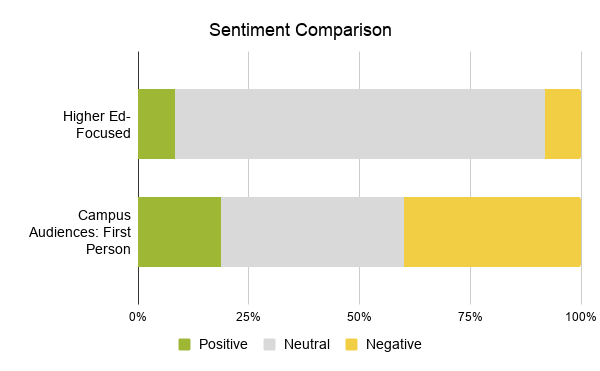 Community College Student Insights
Community College Student Insights
Many of the student insights we shared in prior Briefings remain relevant (e.g., online class frustrations, focus on basic needs and mental health, predominantly sadness and anger emotions). In our final Briefing, I want to illustrate how insights we’d previously identified about students at four-year campuses are beginning to apply to community college students. Over the last three weeks, community college has been a prevailing topic. I believe these institutions have a unique opportunity to attract students and demonstrate their value proposition this year. One of the best ways to share a value proposition is through authentic, student-created content. Of course, this can be the hardest content to find and share, since you likely can’t create it yourself.
Last week, one of the community college mentions in our dataset came from a former community college student who successfully transferred to a four-year university. This mention was on YouTube, something we haven’t focused on much in our Briefings but have written about extensively on our blog. It’s an important social network for high school students. In the 2019 RNL E-Expectations Trend Report, 69 percent of high school seniors and 72 percent of high school juniors reported using YouTube on a daily basis, and 44 percent of high school seniors and 37 percent of high school juniors said YouTube was best for researching colleges. Is this true for prospective community college students? I’m starting to think so.
Michelle, a YouTuber who publishes regularly on her channel The M Blog for about 4,000 subscribers, posted a new video on May 12: My College Journey: Community College to 4 Year. In the video, she shares that she attended community college for five semesters and got a lot out of her experience, including a study abroad program in London. Michelle also talked about how the community college experience helped her figure out what to look for in her transfer institution. She applied to three and got into each one, ultimately choosing to attend the University of San Francisco, which she’s graduating from this year. Every comment on Michelle’s video is from a prospective, current, or former community college student, and four institutions (both community colleges and transfer campuses) are mentioned by name.
Michelle is well spoken and got some good engagement on her video, so I dug a little deeper. Her channel is full of content that promotes community colleges. Previous videos she’s published include: CC Student talks Marketing Major: Salary, Degree, How to do it! (over 80,000 views), 5 Things to Expect on Your First Day of Community College (over 54,000 views), Top 5 Freshman Mistakes | Community College (over 16,000 views), Every Must Know for the First Day of CC (over 16,000 views), and Pick the Right College Classes | First Year CC Advice (6,000 views). But the views aren’t the metric to get excited about here—she gets lots of insightful comments from students. Learn more about why this is important in Sonarian Steve’s blog post, The Iceberg Effect.
The most up-voted comment on one of her most popular videos is, “I wish more people would make videos about going to community college.” If you work at a community college, don’t think this means you need to immediately invest more resources in video production. Students want authentic content from people like Michelle. You probably have them on your campus and can encourage them, or even share general content like Michelle’s with your prospective and admitted students. Learn more in another of Steve’s posts, The Medium Is the Message.
What Students Left in their Campus Residences
As you shift your thinking to summer and fall, don’t forget that many of your students still have belongings left on campus. In the r/college subreddit, over 200 students shared the worst thing they left behind on campus. Tales of forgotten textbooks, medication, retainers, and even pet fish that still remain on campus or in apartments will remind you that life is far from normal, even as the semester comes to an end.
Summary from 10 Weeks of Briefings
Mentions of the Pandemic Settled in April and May
Conversation volume about higher education and the pandemic was highest in March, then settled into a fairly consistent pattern in April and May with about half as much conversation as March’s peak. It will be interesting to see if conversations spike in the fall when institutions take varied approaches to the new semester and the virus continues to make its way through the population.
 As mentioned in our May 5 Briefing, I’m not entirely convinced the conversation is actually decreasing. Rather, the way people talk about higher education and the pandemic is changing. As we figure out our new normal, the pandemic has become an accepted part of the present as well as the future. It’s not necessary to mention “coronavirus,” “COVID-19,” or even “online classes” when talking about its impact on the industry. Most conversations about fall semester, tuition prices, campus budgets, and college choice—both online and off—have a tie to the pandemic whether or not it’s explicitly referenced.
As mentioned in our May 5 Briefing, I’m not entirely convinced the conversation is actually decreasing. Rather, the way people talk about higher education and the pandemic is changing. As we figure out our new normal, the pandemic has become an accepted part of the present as well as the future. It’s not necessary to mention “coronavirus,” “COVID-19,” or even “online classes” when talking about its impact on the industry. Most conversations about fall semester, tuition prices, campus budgets, and college choice—both online and off—have a tie to the pandemic whether or not it’s explicitly referenced.
Students More Likely to Converse on Forums
While the majority of higher ed-focused conversation occurred on social media (especially Twitter), first-person conversation from students was much more likely to occur on forums (especially Reddit). Sometimes, even Tumblr was more popular with students than social media sites like Twitter. While this was a consistent trend in our dataset, we’ve seen large differences in Twitter or Reddit use from campus to campus. Understanding where your current and prospective students are most likely to share online is an important component of social listening intelligence.
Higher Ed-Focused Content Distribution—March 13 to May 19
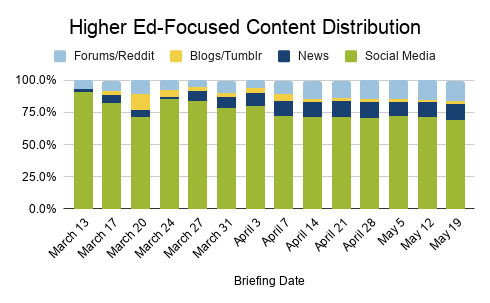 Student Content Distribution—March 13 to May 19
Student Content Distribution—March 13 to May 19
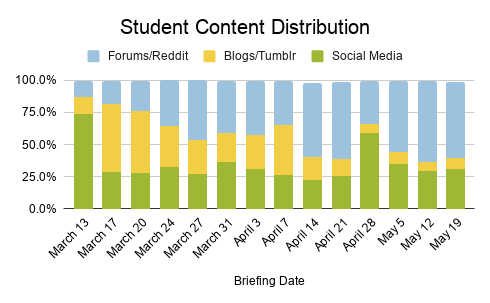 Negative Sentiment Overshadowed Positive; Appeared to Begin Decreasing in May
Negative Sentiment Overshadowed Positive; Appeared to Begin Decreasing in May
Conversations about the coronavirus and higher education were more negative than positive and first-person campus audiences (i.e., prospects, students, their family and friends, alumni) were more likely to display both positive and negative sentiment in their online conversations. Please note that in the following charts, the Y-axis has been adjusted to show the patterns more clearly.
Negative sentiment for higher ed-focused conversation hovered around 20 percent of mentions for most of our Briefings, although there were signs it was on a downward trend in May. First-person campus audiences were generally about twice as negative than the general public.
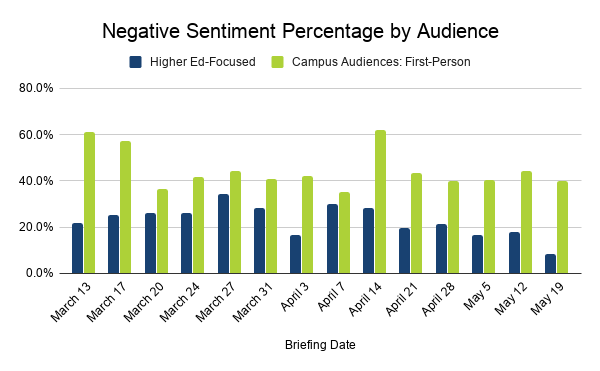 Positive sentiment for higher ed-focused conversation varied between five and ten percent of mentions for most Briefings. First-person campus audiences were more positive; about 15 to 25 percent of mentions displayed positive sentiment starting in April.
Positive sentiment for higher ed-focused conversation varied between five and ten percent of mentions for most Briefings. First-person campus audiences were more positive; about 15 to 25 percent of mentions displayed positive sentiment starting in April.
 Stay Connected with Campus Sonar
Stay Connected with Campus Sonar
This is our last Coronavirus Higher Education Industry Briefing. As we head into summer, conversation volume will decrease, students will focus even more on their specific campuses versus the industry as a whole, and you’ll be deep into fall planning. So the timing is right to call it a wrap on our Briefings.
A lot of new folks found Campus Sonar from these Briefings. If that’s you, we're extra grateful for your interest. If you’d like to stay in touch some other way, our monthly newsletter awaits. We share the latest on social listening in higher ed the third Tuesday of every month, and we love our subscribers.
 The post Coronavirus Higher Education Industry Briefing: May 19 originally appeared on Campus Sonar's Brain Waves blog.
The post Coronavirus Higher Education Industry Briefing: May 19 originally appeared on Campus Sonar's Brain Waves blog.
